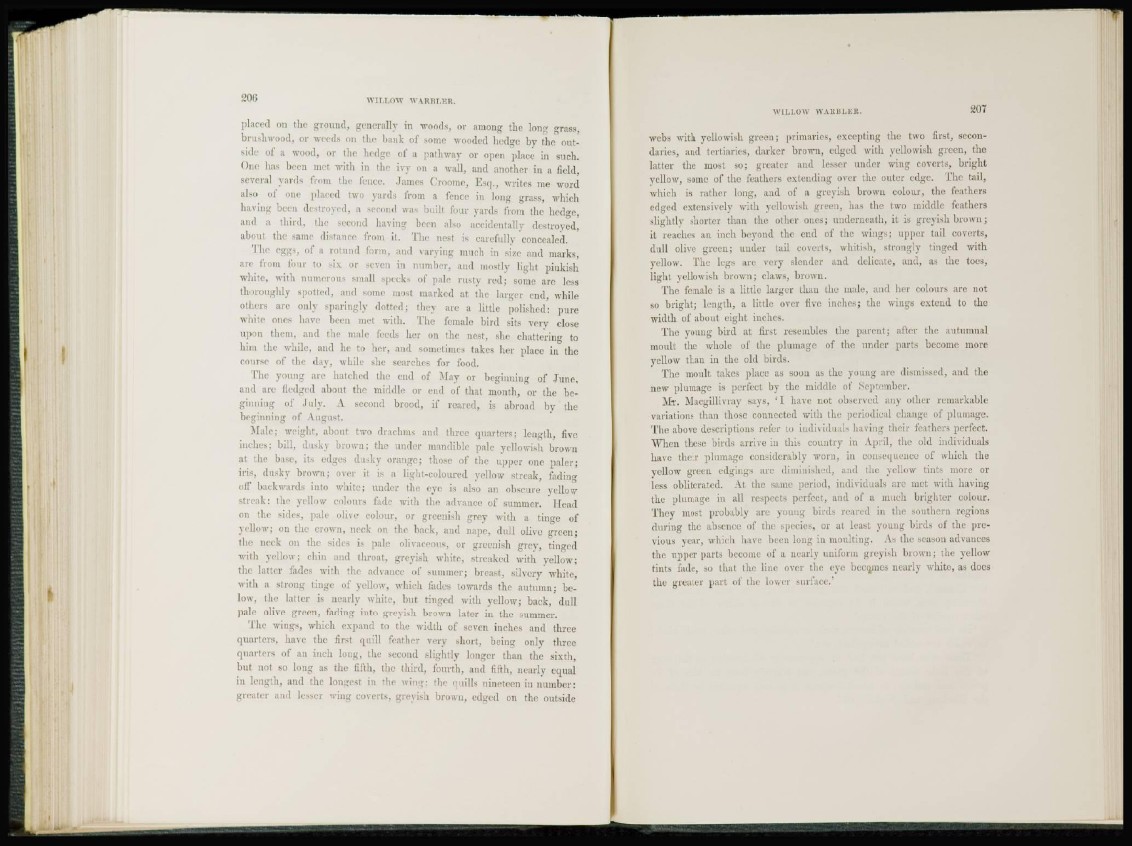
W I L L O W W \ H I ! L E R.
placed i>n the ground, generally in woods, or among the long grass,
brushwood, or weeds on the bank of some wooded hedge by the outside
of a wood, or the hedge of a pathway or open place in such.
One has been met with in the ivy on a wall, and another in a field,
several yards from the fence. James Oroome, Esq., writes me word
also of one placed two yards from a fence in long grass, which
having been destroyed, a second was built four yards from the hedge,
and a third, the second having been also accidentally destroyed,
about the same durance from it. The nest is carefully concealed.
The eggs, of a rotund form, and varying much in size and marks,
are from four to six. or seven in number, and mostly light pinkish,
white, with numerous small specks of pale rusty red; some are less
thoroughly spotted, and some most marked at the larger end, while
others arc only sparingly dotted; they are a little polished: pure
•white ones have been met with. The female bird sits very close
upon them, and the male feeds her on the nest, she chattering to
him the while, and lie to her, and sometimes takes her place in the
course of the day, while she searches for food.
The young are hatched the end of May or beginning of June,
and are fledged about the middle or end of that month, or the beginning
of Inly. A second brood, if reared, is abroad by the
beginning of August.
Male; weight, about two drachms and three quarters; length, five
inches; bill, dusky brown; the under mandible pale yellowish brown
at the base, its edges dusky orange; those of the upper one paler;
iris, dusky brown; over it is a light-coloured yellow streak, fading
off backwards into white; under the eye is also an obscure yellow
streak: the yellow colours fade with the advance of summer. Head
on the sides, pale olive colour, or greenish grey with a tinge of
yellow; on the crown, neck on the back, and nape, dull olive green;
the neck on the sides is pale olivaceous, or greenish grey, tinged
with yellow; chin and throat, greyish white, streaked with yellow;
the latter fades with the advance of summer; breast, silvery white,
with a strong tinge of yellow, -which fades towards the autumn; below,
the latter is nearly white, but tinged with yellow; back, dull
pale olive green, fading into greyish brown later in the summer.
The wings, which expand to the width of seven inches and three
quarters, have the first (pull feather very short, being only three
quarters of an inch long, the second slightly longer than the sixth,
but not so long as the fifth, the third, fourth, and fifth, nearly equal
in length, and the longest in the wing: the quills nineteen in number:
greater and lesser wing coverts, greyish brown, edged on the outside
WILLOW \VA11BLLR. '-¿01
webs with yellowish green; primaries, excepting the two first, secondaries,
and tertiaries, darker brown, edged with yellowish green, the
latter the most so; greater and lesser under wing coverts, bright
yellow, some of the feathers extending over the outer edge. The tail,
which is rather long, and of a greyish brown colour, the feathers
edged extensively with yellowish green, has tin1 two middle feathers
slightly shorter than the other ones; underneath, it is greyish brown;
it reaches an inch beyond the cud of the wings; upper tail coverts,
dull olive green; under tail coverts, whitish, strongly tinged with
yellow. The legs are very slender and delicate, and, as the toes,
light yellowish brown; claws, brown.
The female is a little larger than the male, and her colours are not
so bright; length, a little over five inches; the wings extend to the
width of about eight inches.
The young bird at first resembles the parent; after the autumnal
moult the whole of the plumage of the tinder parts become more
yellow than in the old birds.
The moult takes place as soon as the young are dismissed, and the
new plumage is perfect by the middle of September.
Mr. Macgillivray says, ' 1 have not observed any other remarkable
variations than those connected with the periodical change of plumage.
The above descriptions refer to individuals having their feathers perfect.
When these birds arrive in this country in April, the old individuals
have their plumage considerably worn, in consequence of which the
yellow green edgings are diminished, and the yellow tints more or
less obliterated. At the same period, individuals are met with having
the plumage in all respects perfect, and of a much brighter colour.
They most probably are young birds reared in the southern regions
during the absence of the species, or at least young birds of the previous
year, which have been long in moulting. As the season advances
the upper parts become of a nearly uniform greyish blown; the yellow
tints fade, so that the line over the eye becomes nearly white, as does
the greater part of the lower surface.'
•